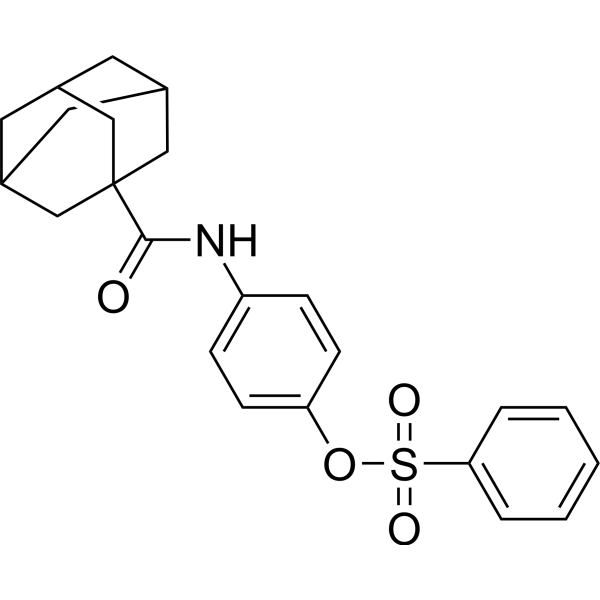Physicochemical Properties
| Molecular Formula | C23H25NO4S |
| Molecular Weight | 411.51 |
| Exact Mass | 411.15 |
| CAS # | 2883495-35-8 |
| PubChem CID | 155806561 |
| Appearance | White to light yellow solid powder |
| Density | 1.342±0.06 g/cm3(Predicted) |
| Boiling Point | 625.8±47.0 °C(Predicted) |
| LogP | 4.8 |
| Hydrogen Bond Donor Count | 1 |
| Hydrogen Bond Acceptor Count | 4 |
| Rotatable Bond Count | 5 |
| Heavy Atom Count | 29 |
| Complexity | 672 |
| Defined Atom Stereocenter Count | 0 |
| InChi Key | NYTJZFKTUQYXEN-UHFFFAOYSA-N |
| InChi Code | InChI=1S/C23H25NO4S/c25-22(23-13-16-10-17(14-23)12-18(11-16)15-23)24-19-6-8-20(9-7-19)28-29(26,27)21-4-2-1-3-5-21/h1-9,16-18H,10-15H2,(H,24,25) |
| Chemical Name | [4-(adamantane-1-carbonylamino)phenyl] benzenesulfonate |
| HS Tariff Code | 2934.99.9001 |
| Storage |
Powder-20°C 3 years 4°C 2 years In solvent -80°C 6 months -20°C 1 month Note: This product requires protection from light (avoid light exposure) during transportation and storage. |
| Shipping Condition | Room temperature (This product is stable at ambient temperature for a few days during ordinary shipping and time spent in Customs) |
Biological Activity
| Targets | CA Ⅱ 0.88 μM (IC50) CA Ⅸ 1.02 μM (IC50) NPP1 1.36 μM (IC50) NPP2 1.35 μM (IC50) NPP3 3.00 μM (IC50) |
| ln Vitro | Compound 1e (Enpp/Carbonic anhydrase-IN-1; IC50s: 0.32, 0.40, 0.58, 0.87, 0.40, 0.96 µM) for K-562, RPMI-8226, SR, COLO 205, HT-29, and SF-539 cells, respectively, suppresses the proliferation of some cancer cells[1]. With IC50s of > 50 μM, Enpp/Carbonic anhydrase-IN-1 (0-2 µM) exhibits minimal cytotoxicity against normal skin fibroblast cells (F180) and normal breast epithelial cells (HME1)[1]. Apoptosis is induced in K-562 cells by Enpp/Carbonic anhydrase-IN-1 (0.32, 0.64 µM) in a dose-dependent manner[1]. |
| Cell Assay |
Cell Proliferation Assay[1] Cell Types: K-562, RPMI-8226, SR, COLO 205, HT-29, SF-539 cells Tested Concentrations: 0-100 µM Incubation Duration: Experimental Results: Inhibited the cell growth with IC50s of 0.32, 0.40, 0.58, 0.87, 0.40, 0.96 µM for K-562, RPMI-8226, SR, COLO 205, HT-29, SF-539 cells, respectively. Apoptosis Analysis[1] Cell Types: K-562 cells Tested Concentrations: 0.32, 0.64 µM Incubation Duration: Experimental Results: Induced apoptosis in a dose-dependent manner. |
| References |
[1]. Design and synthesis of new adamantyl derivatives as promising antiproliferative agents. European Journal of Medicinal Chemistry, 2022. |
Solubility Data
| Solubility (In Vitro) | DMSO : 100 mg/mL (243.01 mM) |
| Solubility (In Vivo) |
Solubility in Formulation 1: ≥ 2.5 mg/mL (6.08 mM) (saturation unknown) in 10% DMSO + 90% (20% SBE-β-CD in Saline) (add these co-solvents sequentially from left to right, and one by one), clear solution. For example, if 1 mL of working solution is to be prepared, you can add 100 μL of 25.0 mg/mL clear DMSO stock solution to 900 μL of 20% SBE-β-CD physiological saline solution and mix evenly. Preparation of 20% SBE-β-CD in Saline (4°C,1 week): Dissolve 2 g SBE-β-CD in 10 mL saline to obtain a clear solution. Solubility in Formulation 2: 2.5 mg/mL (6.08 mM) in 10% DMSO + 90% Corn Oil (add these co-solvents sequentially from left to right, and one by one), suspension solution; with ultrasonication. For example, if 1 mL of working solution is to be prepared, you can add 100 μL of 25.0 mg/mL clear DMSO stock solution to 900 μL of corn oil and mix evenly. (Please use freshly prepared in vivo formulations for optimal results.) |
| Preparing Stock Solutions | 1 mg | 5 mg | 10 mg | |
| 1 mM | 2.4301 mL | 12.1504 mL | 24.3007 mL | |
| 5 mM | 0.4860 mL | 2.4301 mL | 4.8601 mL | |
| 10 mM | 0.2430 mL | 1.2150 mL | 2.4301 mL |
